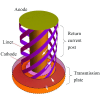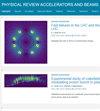Analytical analysis of the generation of a rotating driving magnetic field on the outer surface of a magnetic pinch load with a helical return current post
IF 1.8
3区 物理与天体物理
Q3 PHYSICS, NUCLEAR
Physical Review Accelerators and Beams
Pub Date : 2024-03-19
DOI:10.1103/physrevaccelbeams.27.030401
引用次数: 0
Abstract
A recently emerging approach adopts a directionally time-varying (rotating) magnetic field to drive a pinch load, aiming to mitigate the inherent magneto-Rayleigh-Taylor instability in dynamic pinches. A helical return current post (RCP) serves as a functional structural element capable of generating the requisite driving magnetic field for this purpose in the load region. This paper first calculates the current azimuthally induced on the outer surface of a magnetically pinched load within this type of RCP using a zero-dimensional lumped-parameter circuit model. The results show that the induced current deviates significantly from the presumed “perfect” induced current (100% amplitude) as reported in the literature [S. A. Sorokin, Plasma Phys. Rep. 39, 139 (2013); P. F. Schmit et al., Phys. Rev. Lett. 117, 205001 (2016); G. A. Shipley et al., Phys. Plasmas 26, 102702 (2019); and P. C. Campbell et al., Phys. Rev. Lett. 125, 035001 (2020)], with an effective coefficient of current induction considerably less than 1. However, even when the load is fully compressed to the axis, the effective coefficient does not approach zero but rather converges to a finite value that solely depends on the aspect ratio of the RCP. This is quite favorable for the suppression of magneto-Rayleigh-Taylor instability in the pinch. As for the pointlike pinch, the axial magnetic field does not tend to zero but a finite value, though the effective coefficient tends to zero, and this result may be used to suppress the instability in pinch and improve the time stability and spatiotemporal unity of hot spots. In addition, the anode and cathode plates have the potential to enhance the current induced in the load. This paper then analyzes the axial distribution and time behavior of the induced current adopting an approximate analytical method and numerical integration and finds an approximate invariance that can be well characterized by , the product of the normalized skin depth and time. Similar values of indicate similar axial distribution characteristics. When is lower than, at, or higher than the critical region (), the axial distribution appears dumbbell shaped, nearly flat, and arched, respectively. These distributively induced currents can be exploited to achieve quasispherical, near flat, and dumbbell-shaped implosions, respectively.

带螺旋回流柱的磁性夹持载荷外表面旋转驱动磁场的产生分析
最近出现的一种方法采用定向时变(旋转)磁场来驱动夹紧负载,旨在缓解动态 Z 形夹紧中固有的磁-雷利-泰勒不稳定性。螺旋回流柱 (RCP) 是一种功能性结构元件,能够在负载区产生必要的驱动磁场。本文首先使用零维整块参数电路模型计算了在这种 RCP 内的磁挤压负载外表面的方位感应电流。结果表明,感应电流明显偏离了文献 [S. A., J., J., J., J., J., J., J., J., J., J.] 中假定的 "完美 "感应电流(100% 幅值)。A.Sorokin, Plasma Phys. Rep. 39, 139 (2013); P. F.Schmit 等人,Phys.117, 205001 (2016); G. A.Shipley 等人,Phys. Plasmas 26, 102702 (2019);以及 P. C.Campbell 等人,Phys.然而,即使负载完全压缩到轴上,有效系数也不会趋近于零,而是收敛到仅取决于 RCP 长宽比的有限值。这对抑制 Z 夹角中的磁-雷利-泰勒不稳定性非常有利。至于点状 X 陷波,虽然有效系数趋于零,但轴向磁场并不趋于零,而是趋于有限值,这一结果可用于抑制 X 陷波中的不稳定性,改善热点的时间稳定性和时空统一性。此外,阳极板和阴极板还有可能增强负载中的感应电流。本文采用近似解析法和数值积分法分析了感应电流的轴向分布和时间行为,发现了一个近似不变性,可以用归一化表皮深度与时间的乘积 δt 很好地表征。相似的 δt 值表示相似的轴向分布特征。当 δt 低于、等于或高于临界区域(0.1-0.3)时,轴向分布分别呈现哑铃形、近似扁平形和拱形。利用这些分布式感应电流可分别实现准球形、近扁平和哑铃形的内爆。
本文章由计算机程序翻译,如有差异,请以英文原文为准。
求助全文
约1分钟内获得全文
求助全文
来源期刊

Physical Review Accelerators and Beams
Physics and Astronomy-Surfaces and Interfaces
CiteScore
3.90
自引率
23.50%
发文量
158
审稿时长
23 weeks
期刊介绍:
Physical Review Special Topics - Accelerators and Beams (PRST-AB) is a peer-reviewed, purely electronic journal, distributed without charge to readers and funded by sponsors from national and international laboratories and other partners. The articles are published by the American Physical Society under the terms of the Creative Commons Attribution 3.0 License.
It covers the full range of accelerator science and technology; subsystem and component technologies; beam dynamics; accelerator applications; and design, operation, and improvement of accelerators used in science and industry. This includes accelerators for high-energy and nuclear physics, synchrotron-radiation production, spallation neutron sources, medical therapy, and intense-beam applications.
 求助内容:
求助内容: 应助结果提醒方式:
应助结果提醒方式:


